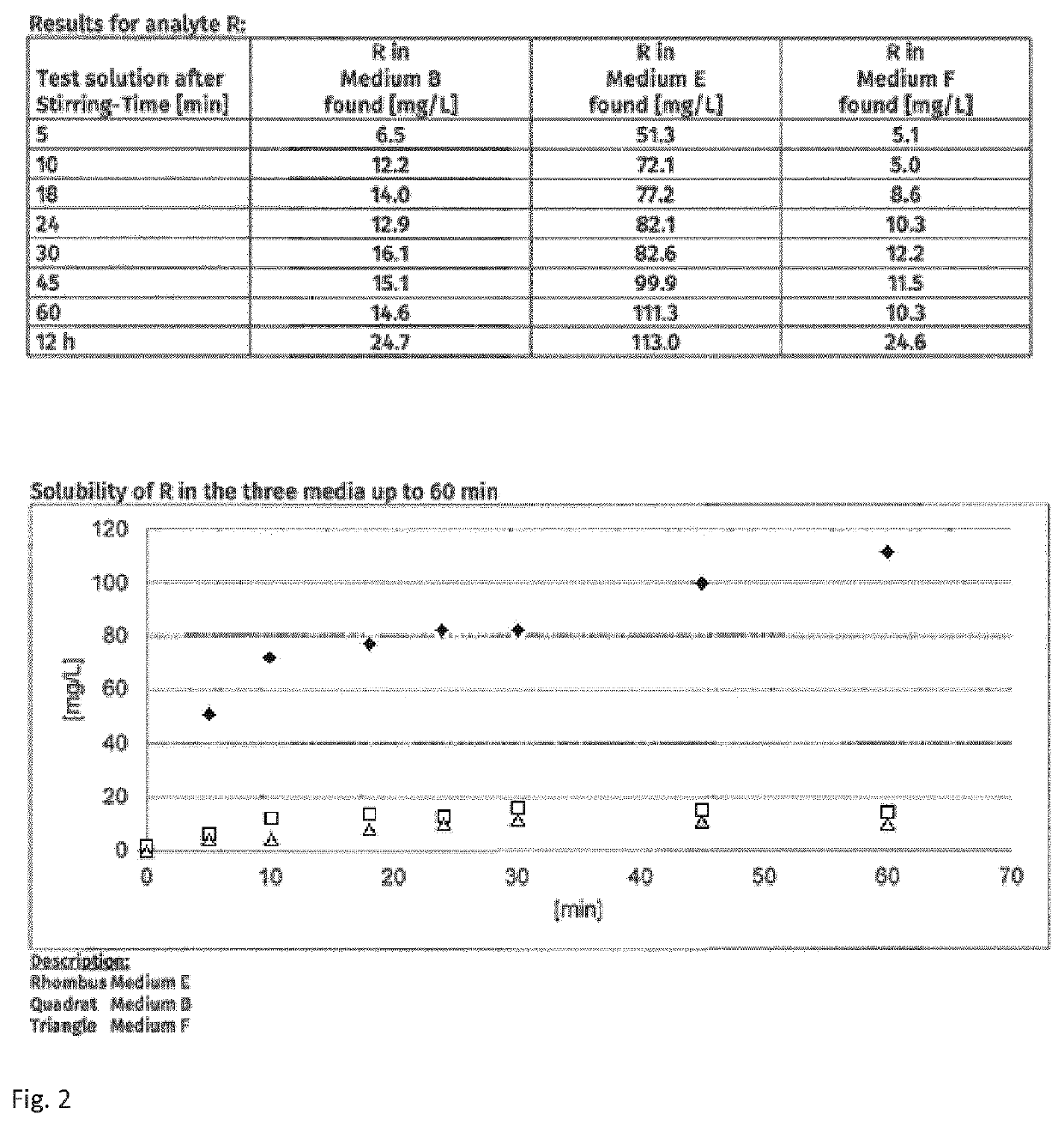Aqueous solution comprising a polyphenol
a technology of aqueous solution and polyphenol, which is applied in the direction of pharmaceutical non-active ingredients, drug compositions, pharmaceutical delivery mechanisms, etc., can solve the problems of acidic ph, food additives, and difficult clinical use of stilbenoid, and achieve the effects of enhancing stilbenoid solubility and/or stability
- Summary
- Abstract
- Description
- Claims
- Application Information
AI Technical Summary
Benefits of technology
Problems solved by technology
Method used
Image
Examples
examples
Methods
[0148]Molecular weight measurement:
[0149]The saccharides are dissolved in extra-pure water in a concentration of 0.5% (w / v). The solutions are heated at 95° C. for 30 minutes. The polymers are analyzed using the following devices: Alliance chromatography system (Waters corporation, Milford, Mass., USA), DAWN-EOS light scattering detector (Wyatt Technology, Santa Barbara, USA) with λ0═658 nm and 16 detectors in the range of angles from 14.4 to 163.3° , K5 flow cell. The polymers are fractionated on a precolumn and three columns having the separation ranges 300-104, 5×104-2×106 and 106-108 (SUPREMA-Gel, PSS Polymer Standards Service GmbH, Mainz, Germany). 100 μl of solution are injected. The fractionation takes place at a temperature of 30° C. and a flow rate of 0.8 ml / min with 0.05M NaNO3 as eluent. The Astra V 5.1.8.0 program (from Wyatt Technology, Santa Barbara, USA) is used to analyze the molecular weight distribution of the samples. Same procedure can be used when molecul...
specific examples
[0157]Purity of tested stilbenoids were[0158]for resveratrol between 99.86% and 99.88%[0159]for piceid between 98.89% and 99.12%.
[0160]Major impurity in piceid was resveratrol of approximately 1%.
[0161]For analysis IR and P and their impurities were separated by a C-18 column with a gradient system and UV-detection at 306 nm.
[0162]Increase of stability or solubility of a stilbenoid by presence of a saccharide, could only be measured within the range of solubility of the saccharide it self.
[0163]Solubility measurements after 1 hour stirring at RT generated some variability in-between measurement series, which might be due to low temperature variations, back-ground measurements and experimental imprecisions. Specifically, variations of concentration of Resveratrol in H2O, without any saccharid, between 0.3 and 6mg / L were observed in-between different series. As a rule of thumb, for calculating factors of increased solubility, the minimal concentration value of Resveratrol in H2O was a...
example 1
[0164]Solubility and stability of Resveratrol and Piceid after one hour stirring at RT, as a function of glucose or icodextrin concentration in a solution, containing 5.4 g / L NaCl, 4.5 g / L NaLactate, 0.275 g / L CaCl2, and 0.051 g / L MgCl2, buffered at pH 3 or pH 7. Solubility was measured after one hour stirring at room temperature, in presence of excess solute, followed by filtering.
[0165]At 0% glucose or icodextrin, pH3 versus Ph7 stabilizes Resveratrol by 2 to 3 times and stabilizes Piceid 3 to 4 times and slightly increases solubility of both stilbenoids.
[0166]At pH7, 0.024% of glucose or Icodextrin stabilize tested stilbenoids 2 to 3 times. 0.075% of Glucose or Icodextrin stabilize tested stilbenoids 3 to 4 times.
[0167]High concentrations of Glucose (24 and 47%), but concentration of Icodextrin of only 0.075%, completely stabilize the tested stilbenoids within the limits of detection and increase their solubility within one hour by a factor 1.5 to 2.
[0168]Highest tested glucose c...
PUM
| Property | Measurement | Unit |
|---|---|---|
| concentration | aaaaa | aaaaa |
| concentration | aaaaa | aaaaa |
| concentration | aaaaa | aaaaa |
Abstract
Description
Claims
Application Information
 Login to View More
Login to View More - R&D
- Intellectual Property
- Life Sciences
- Materials
- Tech Scout
- Unparalleled Data Quality
- Higher Quality Content
- 60% Fewer Hallucinations
Browse by: Latest US Patents, China's latest patents, Technical Efficacy Thesaurus, Application Domain, Technology Topic, Popular Technical Reports.
© 2025 PatSnap. All rights reserved.Legal|Privacy policy|Modern Slavery Act Transparency Statement|Sitemap|About US| Contact US: help@patsnap.com



